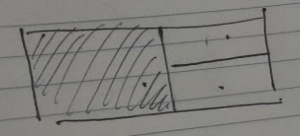I spent my morning sessions at Twitter Math Camp working with David Wees, Kaitlin Ruggiero, and Jasper DeAntonio on the Contemplate then Calculate instructional routine: experiencing it, unpacking it, and rehearsing it as teachers. I’m excited to put it into action this year, and I learned a ton in the sessions both about the routine itself and the benefits of the thinking that goes into it. A quick summary of Contemplate then Calculate:
The routine starts with a mathematical task. Here are three that David, Kait and Jasper modeled with on the first day:



The task is launched by clarifying the goal of the routine — to look for shortcuts or strategies using mathematical structure. The image is flashed and then hidden, without a question, for about a second. Then, students get a chance to talk and and share what they noticed that they think is mathematically important. The image goes back up, clarifying the problem if necessary, and students try to calculate in their heads, using whatever strategies they can find, often with the help of the noticings. Students then get a chance to share strategies with each other, and the teacher selects and sequences strategies to share and annotate for the whole class. Finally, the class engages in a meta-reflection, thinking about how the structure used in different shortcuts could be useful in other contexts.
That’s a pretty high-level overview; there’s a ton more subtlety to it that’s worth exploring. Resources from the morning sessions are here, and this document has links to videos and other great resources to learn about Contemplate then Calculate.
I loved experiencing the routine as both a learner and a teacher, and I think it gets at some mathematical habits of mind that I don’t do well in my class. But what I’m particularly fascinated with is what went into planning to teach a Contemplate then Calculate routine.
During the session I worked with Sadie Estrella, planning to co-teach the routine. There are tasks on the New Visions website for Algebra I through Algebra II, and each includes slides and other relevant information. It took us about 15 minutes to work through a planning template to prepare to teach the routine; I’m sure this would get faster if I did it more often. And, since the routine doesn’t require any handouts and the slides were made, we were ready to go.
This is a pretty significant contrast with my usual lesson planning time, which is largely spent creating the handouts I’m going to give to students, fighting with formatting, spending only a fraction of my planning time thinking about what I’m going to do and even less on how I’m going to do it.
David ended the last session with these slides, which were particularly striking to me.


This gets at a big reason why I’m excited about this routine. During our planning, we were thinking almost exclusively about student thinking — about what strategies students were likely to use, what mathematics in those strategies was worth highlighting, and where the task fits into the broader scope of the mathematics students would learn. I learned a ton just from those minutes I spent preparing to teach the routine. And while I’m likely to be generating my own tasks for some classes this year, the fact that so much of the routine is set will allow me to continue focusing as much of my thinking as possible on student thinking and how I am going to move that thinking forward. That’s a pretty cool thing.
Many of us will be using the #CthenC hashtag to share about this routine over the next year. If you’re interested, follow along, or give it a shot yourself and share how it went!






